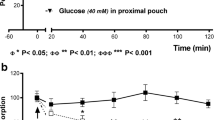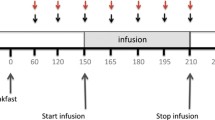Summary
Jejunal perfusion was performed in 12 healthy volunteers to evaluate the dose dependent effects of loperamide on intestinal absorption, stimulated secretion and transit.
In 6 volunteers intestinal perfusion of the jejunal segment with isotonic NaCl solution was followed by addition of loperamide in increasing doses (2–8 mg·l−1). The volunteers were pretreated with 1 mg·l−1 prostaglandin E2 (PgE2) in the perfusate before addition of 4 mg·l−1 loperamide. Phenolsulphonphtalein (PSP) boluses (2 ml) were given to measure mean transit time (MTT).
Loperamide 2 mg·l−1 converted the minor secretion after perfusion with the standard solution (water −1.45 ml·min−1, Na −0.09 and Cl −0.04 mmol·min−1) to absorption (water 0.93 ml·min−1, Na 0.23, Cl 0.25 mmol·min−1) within 15 min. Higher doses of loperamide did not increase absorption.
The addition of PgE2 induced net secretion of water (−4.48 ml·min−1) and electrolytes (Na −0.57, Cl −0.51 mmol·min−1). Loperamide 4 mg·l−1 significantly diminished the PgE2-induced net secretion by approximately 50%.
Loperamide dose dependently increased the MTT from 6 (2 mg·l−1) to 13.3 min (8 mg·l−1). MTT was still delayed 60 min after a wash out period (10.5 min).
It is concluded that loperamide had a dual effect or intestinal activities stimulating absorption and prolonging intestinal transit time with rising doses.
Similar content being viewed by others
References
Steffen R, Heusser R, Helminger A, Schär M (1987) Preliminary results of a controlled study on the efficacy and side-effects of various agents in the therapy of traveller's diarrhoea. In: DuPont HL (ed) Acute infectious diarrheoa. Proceedings of the IXth International Congress of Infectious and Parasitic Diseases. Janssen Research Foundation. Munich, pp 37–41
Awouters F, Niemegeers CJE, Janssen PAJ (1983) Pharmacology of antidiarrheal drugs. Ann Rev Pharmacol Toxicol 23: 279–301
Schiller LR, Santa Ana CA, Morawski SG, Fordtran JS (1974) Mechanism of the antidiarrheal effect of loperamide. Gastroenterology 68: 94–104
Hughes S, Higgs NB, Turnberg LA (1984) Loperamide has antisecretory activity in the human jejunum in vivo. Gut 25: 931–935
Ewe K, Summerskill R (1965) Transfer of ammonia in the human jejunum. J Lab Clin Med 65: 839–847
Schedl HP, Clifton J (1961) Small intestinal absorption of steroids. Gastroenterology 41: 491–499
Zierler KL (1962) Circulation times and the theory of indicatordilution methods for determining blood flow and volume. In: Hamilton WF, Derr P (eds) Handbook of physiology, Vol 1/18. American Physiological Society, Washington (Circulation), pp 585–615
Barreiro MA, McKenna RD, Beck IT (1968) Determination of transit time in the human jejunum by the single-ingestion indicator-dilution technic. Am J Dig Dis 13: 222–233
Soergel KH (1979) Flow measurements of test meals and fasting contents in the human small intestine. In: Demling L, Ottenjahn R (eds) Gastrointestinal motility. Thieme, Stuttgart, pp 81–95
Page EB (1963) Ordered hypothesis for multiple treatments. A significance test for linear ranks. J Am Slat Assoc 58: 216–230
Kreek MJ, Schaefer RA, Hahn EF, Fishman J (1983) Naloxone, a specific opioid antagonist, reverses chronic idiopathic constipation. Lancet I: 261–262
Kachel G, Ruppin H, Hagel J, Barina W, Meinhardt M, Domschke W (1986) Human intestinal motor activity and transport: effects of a synthetic opiate. Gastroenterology 90: 85–93
Kachur JH, Miller RJ, Field M (1980) Control of guinea pig intestinal electrolyte secretion by a δ opiate receptor. Proc Natl Acad Sci USA 77: 2753–2756
Dobbins JW, Racusen L, Binder HJ (1980) Effect of D-Ala-Met enkephalin amide on ion transport in rabbit ileum. J Clin Invest 66: 19–28
Kamath JK, Binder JH, Dobbins JW (1980) Mechanism of enkephalin effect on ion transport: role of calcium. Clin Res 28: 279A
Racusen L, Binder J, Dobbins JW (1979) Met-enkephalin stimulates ion transport in rabbit ileum. Clin Res 27: 456A
Djärv L, Sjödahl R (1981) Elemination of loperamide in patients treated for chronic diarrhoea. Drugs Exptl Clin Res VII: 25–30
Kaufman PN, Krevsky B, Malmud LS, Maurer AH, Somers MB, Siegel JA, Fisher RS (1988) Role of opiate receptors in the regulation of colonic transit. Gastroenterology 94: 1351–1356
Basilisco G, Bozzani A, Camboni G, Recchia M, Quatrini M, Conte D, Penagini R, Bianchi PA (1985) Effect of loperamide and naloxone on mouth-to-caecum transit time evaluated by lactulose hydrogen breath test. Gut 26: 700–703
Fordtran JS, Floyd CR, Carter NW (1968) The mechanisms of sodium absorption in the human small intestine. J Clin Invest 47: 884–900
Parsons DS (1956) The absorption of bicarbonate-saline solutions by the small intestine of the white rat. Q J Exptl Physiol 41: 410–413
Fordtran JS, Rector FC, Ewton MF, Soter N, Kinney J (1965) Permeability characteristics of the human small intestine. Clin Invest 44: 1935–1944
Al-Awquati Q, Greenough WB (1972) Prostaglandins inhibit intestinal sodium transport. Nature 238: 26–27
Matuchansky C, Bernier JJ (1973) Effect of prostaglandin E 1 on glucose, water and electrolyte absorption in the human jejunum. Gastroenterology 64: 1111–1118
Rask-Madsen J, Bukhave K (1981) The role of prostaglandins in diarrhoea. In: Read NW (ed) Diarrhoea: New Insights. Janssen Pharmaceuticals Ltd., Marlow (Clinical Research Review), pp 33–48
Matuchansky C, Bernier JJ (1976) Further studies on PGE1-induced jejunal secretion of water and electrolytes in man with special reference to the influence of ethacrynic acid, furosemide and aspirin. Gastroenterology 71: 274–281
Turnberg LA (1983) Antisecretory activity of opiates in vitro and in vivo in man. Scand J Gastroenterol 18: 79–83
Lange AP, Secher NJ, Amery W (1977) Prostaglandin induced diarrhoea treated with loperamide or diphenoxylate. Acta Med Scand 202: 449–454
Goerg KJ, Wanitschke R, Meyer zum Büschenfelde KJ (1987) Mechanism of actions of antidiarrheals: focus on loperamide. In: DuPont JL (ed) Acute Infectious Diarrhoea: Role of Drug Therapy. Proceedings of the IXth International Congress of Infectious and Parasitic Diseases Janssen Research Foundation. Munich, pp 15–24
Donowitz M (1983) Calcium in the control of active Na and Cl transport and involvement in neurohumoral action. Am J Physiol 245: G167–177
Fondacaro JD, Henderson LS (1985) Evidence for proteinkinase C as a regulator of intestinal electrolyte transport. Am J Physiol 274: G422–426
Glenny JR, Weber K (1980) Calmodulin-binding proteins of the microfilaments present in the isolated brush border and microvilli of intestinal epithelial cells. J Biol Chem 255: 1051–1054
Donowitz M, Askarof N (1982) Calcium dependence of basal electrolyte transport in rabbit ileum. Am J Physiol 243: G28–35
Author information
Authors and Affiliations
Rights and permissions
About this article
Cite this article
Press, A.G., Ewe, K., Schmidt, J. et al. Effect of loperamide on jejunal electrolyte and water transport, prostaglandin E 2-induced secretion and intestinal transit time in man. Eur J Clin Pharmacol 41, 239–243 (1991). https://doi.org/10.1007/BF00315436
Received:
Accepted:
Issue Date:
DOI: https://doi.org/10.1007/BF00315436




